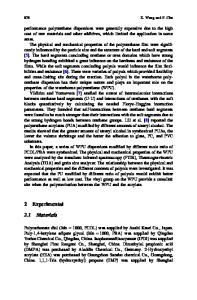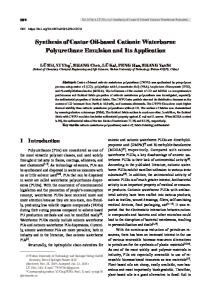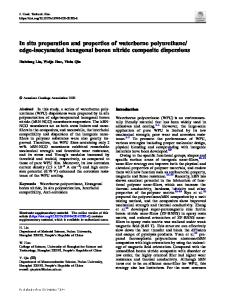Reinforcement of Waterborne Polyurethane Films with Poly(acrylic acid)-Modified Palygorskite Fibers
- PDF / 1,082,282 Bytes
- 6 Pages / 609 x 794 pts Page_size
- 46 Downloads / 297 Views
ISSN 1229-9197 (print version) ISSN 1875-0052 (electronic version)
Reinforcement of Waterborne Polyurethane Films with Poly(acrylic acid)-Modified Palygorskite Fibers Yu Mao1, Lingli Ni1*, Changyou Yang1, Peng Cai1, Weigang Du2, and Xiaoyan Gao2* 1
Key Laboratory for Palygorskite Science and Applied Technology of Jiangsu Province, College of Chemical Engineering, Huaiyin Institute of Technology, Huai’an 223003, China 2 National & Local Joint Engineering Research Center for Deep Utilization Technology of Rock-salt Resource, Huaiyin Institute of Technology, Huaian 223003, China (Received July 23, 2019; Revised December 10, 2019; Accepted December 29, 2019) Abstract: Palygorskite (PAL) is a natural fibrous clay mineral which attracted tremendous attention as reinforcing agent to polymers. In this paper, a facile and environmental friendly modification process of PAL by poly acrylic acid (PAA) via insitu polymerization in PAL/water gel has been reported. The effects of PAA modified PAL (PAA-PAL) on the mechanical and thermal properties of waterborne polyurethane (WPU) nanocomposites have been investigated. Scanning electron microscopy (SEM) demonstrated that the dispersion of PAL has improved dramatically after PAA modification. Tensile tests showed that PAA-PAL has a significant reinforcement effect on WPU matrix. Addition of 10 wt% PAA-PAL, the tensile strength and the Young’s modulus of WPU composites increased 235 % and 388 %, respectively. Furthermore, the thermal stability of WPU also has been distinctly improved via addition of PAA-PAL. Keywords: Waterborne polyurethane, Palygorskite, Poly(acrylic acid), Mechanical property
[23]. However, due to the van der Waals and hydrogen bonding interactions between the PAL intervals, the raw PAL exists in the form of micrometric aggregates and crystal bundles, which greatly impeded its applications in polymer composites [24]. Up to date, there are few studies reported on the PAL reinforcing WPU [25-27]. Peng et al. prepared a series of waterborne polyurethane/palygorskite nanocomposites by in-situ polymerization [25]. The experimental results showed that the isocyanate modified PAL fibers were uniformly dispersed in WPU. As a result, the thermal stability and mechanical properties of WPU were significantly improved. Wang et al. used silylated PAL to reinforce soybean oilbased polyurethane [26,27]. The experimental results showed that the tensile strength of such WPU increased by 303 % with the addition of 12 wt% silylated PAL [27]. However, complicated PAL modification process, expensive reactive agents and organic solvents, as well as limited grafting amount of organic functions onto PAL surface highly hindered their practical applications. Herein, we report a novel and simple modification process of PAL by poly acrylic acid (PAA) with cheap acrylic acid agents via in-situ polymerization in PAL/water gel, in order to eliminate limitations of expensive modification agents and organic solvents existed in the traditional processes. Furthermore, the PAL aggregates can be s
Data Loading...











